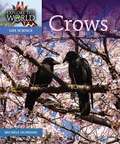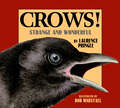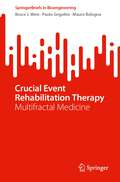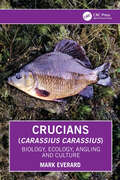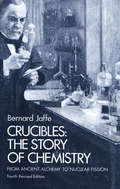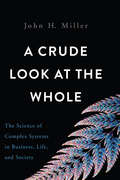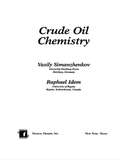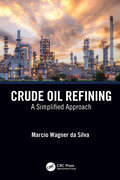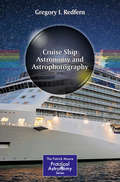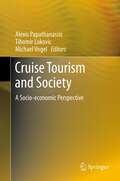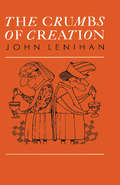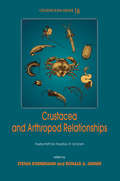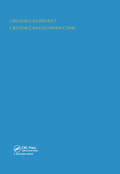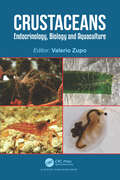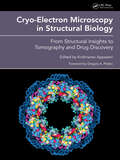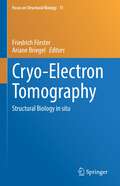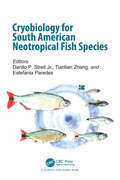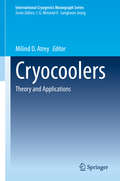- Table View
- List View
Crows: Explore the World Life Science
by Michèle DufresneThis book is about big black birds called crows which can be found in many places.
Crows!: Strange and Wonderful (Strange and Wonderful)
by Laurence PringleYou see them feeding along the sides of roads or flying to the tops of trees. They are known as common crows, but there is nothing common about them. The familiar sound of "caw, caw, caw" is just one of at least twenty-five distinct sounds crows make in order to communicate with one another. Laurence Pringle examines these remarkable creatures in a fact-filled text that explores how crows talk, behave, and survive. With beautifully detailed illustration by Bob Marstall, young readers get a fascinating look into the world of one of the smartest birds on earth in this winner of the John Burroughs Nature Books for Young Readers Award.
Crucial Event Rehabilitation Therapy: Multifractal Medicine (SpringerBriefs in Bioengineering)
by Bruce West Paolo Grigolini Mauro BolognaThis book describes a new strategy for rehabilitation from injury and/or disease using Crucial Event Therapy. Recent studies have shown that individuals can recuperate more rapidly from surgery and other invasive procedures intended to correct the negative effects of disease or injury through the use of life support systems that operate at the body's natural biofrequencies. The same observation has been clinically shown to reverse the degenerative effects of neurodegenerative diseases such as Parkinson’s and Alzheimer's Disease. Crucial Event Therapy describes medicine as the operational control of the functions of the human body treated as a network-of-networks, with 1/f-variable crucial events coding the dynamic states of health and disease through information flow within a network and information exchange between biomedical networks. A new way of thinking based on the statistics of Cortical Events is presented and the relevant literature is suitably referenced. This is an ideal book for biophysicists and data scientists seeking to understand the connection of complexity measures for the study of consciousness with the clinical aspects of designing a rehabilitation strategy.
Crucians (Carassius carassius): Biology, Ecology, Angling and Culture
by Mark EverardThe crucian is a freshwater fish species that has seen a renaissance of interest in angling and conservation communities in Britain. Despite its wide northern European and western Asian distribution, the species is under threat due to multiple causes including the decimation of the small pond habitats upon which it depends. As a small pond specialist, the crucian serves a particularly important role as a charismatic focus encouraging support for the protection and restoration of this highly threatened and much-reduced habitat type and the diversity of other species that it supports.Crucians (Carassius carassius): Biology, Ecology, Angling and Culture takes a comprehensive approach, covering: Biology and ecology, including taxonomy Angling, including location, baits, methods, and former and current record fish Cultural connections, including etymology, artwork and culinary aspects of the fish These sections are supported by a bibliography and beautiful colour imagery. The book offers a fascinating read for conservationists, anglers, freshwater biologists and those with interest in the natural world.
Crucibles: The Story of Chemistry from Ancient Alchemy to Nuclear Fission
by Bernard JaffeThis book is a classic in the field of popular science. Standard reading since the 1930s, it is one of the few historeis of chemistry to concentrate on the lives of the great chemists. Through these dramatic and human stories, it gives an authoritative and entertaining account of the great discoveries and advances in this scientific field. After many printings in three previous editions, this book has been newly revised by the author for this fourth edition. Beginning with Trevisan and his lifelong search for the "philosopher's stone," the author narrates the lives and discoveries of such towering figures as Paracelsus and his chemical treatment of disease; Priestley looking for phlogiston and finding oxygen and carbon dioxide, Lavoisier creating a new language of chemistry; Dalton and his Atomic Theory; Avogadro and the idea of molecules, Mendeleeff arranging the table of elements under his Periodic Law; the Curies isolating radium; Thomson discovering the electron; Moseley and his Law of Atomic Numbers; Lawrence and the construction of the cyclotron; and more. Probably the most dramatic chapter in the book, the account of the development of nuclear fission, ends the story of chemistry at its most monumental achievement. A final chapter discusses some of the consequences of nuclear fission, the discovery of nuclear fusion, and the recent work with subatomic particles. Bernard Jaffe is the author of many other science books and several science textbooks. Upon the original publication of this book, Mr. Jaffe received the Francis Bacon Award for the Humanizing of Knowledge. The American Chemical Society's History of Chemistry Division honored him in 1973 with its Dexter Award for "distinguished achievement in the history of chemistry."
A Crude Look at the Whole: The Science of Complex Systems in Business, Life, and Society
by John H. MillerImagine trying to understand a stained glass window by breaking it into pieces and examining it one shard at a time. While you could probably learn a lot about each piece, you would have no idea about what the entire picture looks like. This is reductionism--the idea that to understand the world we only need to study its pieces--and it is how most social scientists approach their work. In A Crude Look at the Whole, social scientist and economist John H. Miller shows why we need to start looking at whole pictures. For one thing, whether we are talking about stock markets, computer networks, or biological organisms, individual parts only make sense when we remember that they are part of larger wholes. And perhaps more importantly, those wholes can take on behaviors that are strikingly different from that of their pieces. Miller, a leading expert in the computational study of complex adaptive systems, reveals astounding global patterns linking the organization of otherwise radically different structures: It might seem crude, but a beehive’s temperature control system can help predict market fluctuations and a mammal’s heartbeat can help us understand the "heartbeat” of a city and adapt urban planning accordingly. From enduring racial segregation to sudden stock market disasters, once we start drawing links between complex systems, we can start solving what otherwise might be totally intractable problems. Thanks to this revolutionary perspective, we can finally transcend the limits of reductionism and discover crucial new ideas. Scientifically founded and beautifully written, A Crude Look at the Whole is a powerful exploration of the challenges that we face as a society. As it reveals, taking the crude look might be the only way to truly see.
Crude Oil Chemistry
by Vasily Simanzhenkov Raphael IdemCrude Oil Chemistry is foremost a scientifically exact guide to the full family of classical and modern analytical and process technologies in petroleum refining. In widening its vision also to incorporate a geological history of petroleum formation, present-day geopolitical and economic issues, and approaches to redress and improve the delicate ties between the petroleum industry and the environment, this reference succeeds as a total representation of the factors going into the chemistry of crude oil and their outward bound ramifications. The book thoroughly evaluates the chemistry and processing of low API gravity high-sulfur heavy crude oil increasingly relied on in the industry.
Crude Oil Refining: A Simplified Approach
by Marcio Wagner da SilvaThis book provides an overview of crude oil refining processes and presents a deep analysis of the current context and challenges imposed on players in the downstream industry. Crude Oil Refining: A Simplified Approach covers traditional processes of the refining industry, the impact of current trends, and technological routes available to help these players survive in a highly competitive environment. FEATURES Offers a simplified approach to crude oil refining processes Discusses economic information related to the downstream business, including refining margins and profitability Introduces newer trends in the industry, such as petrochemical integration, crude-to-chemicals refineries, and renewables coprocessing in crude oil refineries Presents the challenges related to these new trends and offers technological solutions to overcome them for profitable and sustainable operations Describes how the use of biofuels can minimize the environmental impact of transportation fuel in nations of high demand like Brazil Offering a contemporary view of current challenges and opportunities in the downstream oil and gas business, this practical book is aimed at readers working in the fields of petroleum and chemical engineering.
The Cruelest Miles: The Heroic Story of Dogs and Men in a Race Against an Epidemic
by Gay Salisbury Laney Salisbury"A stirring tale of survival, thanks to man's best friend . . . reflects a transcendent understanding and impeccable research."--Seattle Times When a deadly diphtheria epidemic swept through Nome, Alaska, in 1925, the local doctor knew that without a fresh batch of antitoxin, his patients would die. The lifesaving serum was a thousand miles away, the port was icebound, and planes couldn't fly in blizzard conditions--only the dogs could make it. The heroic dash of dog teams across the Alaskan wilderness to Nome inspired the annual Iditarod Trail Sled Dog Race and immortalized Balto, the lead dog of the last team whose bronze statue still stands in New York City's Central Park. This is the greatest dog story, never fully told until now.
Cruise Ship Astronomy and Astrophotography (The\patrick Moore Practical Astronomy Ser.)
by Gregory I. RedfernEnrich your next sea vacation with this fun how-to guide to observing and doing astrophotography on water. Collecting together the author’s five decades of astrophotography and teaching experience, this book shares all the practical information you will need to start on your own astronomy adventure.Part I is full of practical advice on what to pack, the best ways to enjoy the night sky from your cruise ship observatory, specific astronomical objects and events to look out for, and myriad other useful tips. Part II gives you a crash course on astrophotography at sea, teaching you the nitty-gritty details of taking pictures of the night sky. Proof that it can be done is provided by the many amazing color astrophotographs taken by the author while following the steps laid out in this book.
Cruise Tourism and Society: A Socio-economic Perspective
by Tihomir Lukovic Michael Vogel Alexis PapathanassisThe growth and increased popularity of cruises is accompanied by a number of sustainability issues concerning the environment, the port economies and societies; on board and at shore. The sustainability imperative ultimately leads to operational, economical as well as image-related challenges for the sector's decision-makers and stakeholders. This collection of peer-reviewed papers, presented during the 3rd International Cruise Conference (Dubrovnik, Croatia), seeks to address those issues and contribute to their management in the mid-term.
Cruisin' the Fossil Freeway: An Epoch Tale of a Scientist and an Artist on the Ultimate 5,000-Mile Paleo Road Trip
by Kirk Johnson Ray Troll"A paleontological odyssey that manages to be informative, witty, educational—and enormous fun." —Simon Winchester, author of The Map That Changed the World, Krakatoa, and A Crack in the Edge of the World An epoch tale of a scientist and an artist on the ultimate 5,000-mile paleo road trip.Cruisin' the Fossil Freeway follows the most unusual travels of a paleontologist and an artist as they drive across the American West in search of fossils. Throughout their journey, they encounter "paleonerds" like themselves, people dedicated to finding everything from suburban T. rex to killer Eocene pigs to ancient fossilized forests. This updated editions brings the text up-to-date on new discoveries, new realizations, and new places, along with new art. A fascinating travelogue, Cruisin' the Fossil Freeway shows us that fossils are everywhere if you learn to look for them—even at 65 miles per hour.
Crumbling Genome: The Impact of Deleterious Mutations on Humans
by Alexey S. KondrashovA thought-provoking exploration of deleterious mutations in the human genome and their effects on human health and wellbeing Despite all of the elaborate mechanisms that a cell employs to handle its DNA with the utmost care, a newborn human carries about 100 new mutations, originated in their parents, about 10 of which are deleterious. A mutation replacing just one of the more than three billion nucleotides in the human genome may lead to synthesis of a dysfunctional protein, and this can be inconsistent with life or cause a tragic disease. Several percent of even young people suffer from diseases that are caused, exclusively or primarily, by pre?]existing and new mutations in their genomes, including both a wide variety of genetically simple Mendelian diseases and diverse complex diseases such as birth anomalies, diabetes, and schizophrenia. Milder, but still substantial, negative effects of mutations are even more pervasive. As of now, we possess no means of reducing the rate at which mutations appear spontaneously. However, the recent flood of genomic data made possible by next-generation methods of DNA sequencing, enabled scientists to explore the impacts of deleterious mutations on humans with previously unattainable precision and begin to develop approaches to managing them. Written by a leading researcher in the field of evolutionary genetics, Crumbling Genome reviews the current state of knowledge about deleterious mutations and their effects on humans for those in the biological sciences and medicine, as well as for readers with only a general scientific literacy and an interest in human genetics. Provides an extensive introduction to the fundamentals of evolutionary genetics with an emphasis on mutation and selection Discusses the effects of pre-existing and new mutations on human genotypes and phenotypes Provides a comprehensive review of the current state of knowledge in the field and considers crucial unsolved problems Explores key ethical, scientific, and social issues likely to become relevant in the near future as the modification of human germline genotypes becomes technically feasible Crumbling Genome is must-reading for students and professionals in human genetics, genomics, bioinformatics, evolutionary biology, and biological anthropology. It is certain to have great appeal among all those with an interest in the links between genetics and evolution and how they are likely to influence the future of human health, medicine, and society.
The Crumbs of Creation: Trace elements in history, medicine, industry, crime and folklore
by J LenihanOf the 90 chemical elements that occur in nature, only a dozen are found in easily measurable amounts in the human body. The rest are trace elements, present at such low concentrations that most of them were, until quite recently, beyond the reach of detection. The Crumbs of Creation reviews the absorbing story of trace elements in medicine, history, industry, crime, and folklore, showing how the study of their properties can help us survive through a better understanding and control of our environment. Written in an easy-to-read, entertaining style, the book consists of interrelated anecdotes grouped together in relevant chapters. Although readers will derive much entertainment from this book, there is an underlying seriousness to the topics.
Crush Mechanics of Thin-Walled Tubes
by Dai-heng ChenThin-walled structures can be used to absorb impact energy during a vehicle collision. Crush Mechanics of Thin-Walled Tubes describes the analysis and design of these lightweight elements and thoroughly explains the deformation behaviors of thin-walled hollow members under crushing loading. The book covers, in detail, thin-walled structures—under axial compression, bending, and torsion. It provides a complete understanding of the underlying concepts and mechanisms of energy absorption components, includes analysis techniques, and covers existing theoretical approaches along with the author’s research.Geared toward engineering students, practicing mechanical and structural engineers, and researchers interested in analyzing energy absorption and designing structures that may undergo impacts, this book: Addresses axial compression of circular and square tubes, and bending and torsion of tubes Summarizes the mechanism of collapse and associated calculations for the initial peak force and the average compressive force Explores two factors controlling the axial collapse of a plate Investigates systematically the deformation characteristics of corrugated tubes under axial crush Provides an understanding of the collapse behavior of members undergoing bending deformation when trying to evaluate strength and energy-absorption characteristics Looks at the bending deformation of circular and square tubes Explains the characteristic flattening phenomenon, the maximum moment in bending deformation, and the moment-rotation relation during bending collapse Discusses the collapse behavior of thin-walled structures with an open cross section during axial crushing and bending deformation Includes the proposition of a new method for evaluating the maximum bending moment of square tubes with consideration of sidewall buckling Proposes a new technique that can be used to determine the relation between the bending moment M and the rotation angle θ Presents analysis methods for predicting the maximum torsion moment in each case A shelf-worthy reference showcasing structural mechanics, Crush Mechanics of Thin-Walled Tubes provides a basic understanding of the fundamental concepts and mechanisms of crushing deformations in thin-walled structures and serves as a guide for both teaching and self-study.
Crustacea and Arthropod Relationships
by Stefan Koenemann Ronald A. JennerCompared to other arthropods, crustaceans are characterized by an unparalleled disparity of body plans. Traditionally, the specialization of arthropod segments and appendages into distinct body regions has served as a convenient basis for higher classification; however, many relationships within the phylum Arthropoda still remain controversial.
Crustacean Biogeography
by Robert H. GoreThis work covers the geographical distribution of Crustaceans with hypotheses on how the distribution took place, based on fossil and recent records.
Crustacean Egg Production
by ADRIAN WENNER & ARMAND KURISThis title discusses egg formation, release, and development, variations in life history patterns, population, and fisheries aspects regarding crustaceans.
Crustacean Issues 2: Larval Growth (Advances in Crustacean Research #2)
by Adrian WennerFirst published in 1985. CRC Press is an imprint of Taylor & Francis.
Crustacean Issues 3: Factors in Adult Growth (Advances in Crustacean Research #3)
by Adrian M. WennerFirst published in 1985. CRC Press is an imprint of Taylor & Francis.
Crustaceans: Endocrinology, Biology and Aquaculture
by Valerio ZupoAnyone who attempts to study crustaceans soon realizes that there are many science fields involved. As a major subphylum of Arthropods—the largest phylum in the animal kingdom—crustaceans exhibit an extraordinary diversity of taxa, shapes, physiology and styles of life. These invertebrates play key ecological roles in all aquatic environments, while only a few species are adapted to sub-aerial and humid environments. Their evolutionary success is not only due to a wide set of morphological and biological adaptations, but also because of some key features, e.g., their peculiar endocrinology. In addition, crustaceans are characterized by chemical and optical sensors deserving attention because they play important biological roles, linked to chemical ecology issues, and their functioning is impaired by global changes and ocean acidification. Several crustaceans have critical roles in aquatic ecology (e.g., copepods in the plankton, amphipods and isopods in the benthos). Select species are technologically important as "models" for scientific research. Furthermore, aquaculture of several decapod crustaceans is important for providing high protein products to meet the need for nutrition. Understanding the physiology and ecology of crustaceans is important to fulfill these diverse purposes and practical applications. In this book, leading world scientists have pooled their excellence to provide vibrant and expert views of fundamental biological and physiological mechanisms involving crustaceans. To this end, a comprehensive view of crustacean endocrinology and reproductive ecology is provided, along with information about their molecular physiology, adaptations, aquaculture and welfare. In particular, we attempted to span the breadth of their adaptations, presenting behavioral and physiological peculiarities, considering key groups of crustaceans to describe general features and global biodiversity. This book is offered as a tool for students and scientists in various fields of physiological, ecological, biotechnological and aquacultural research.
Cryo-Electron Microscopy in Structural Biology: From Structural Insights to Tomography and Drug Discovery
by Krishnarao AppasaniCryo-electron microscopy, in combination with tomography, has emerged as a new technology for visualizing molecular structures at a resolution beyond even 1 Å. Using this technology has revealed the native molecular details of viruses, membranes, enzymes, ribosomes, and cells. This comprehensive volume brings together authoritative overviews of these methods from structural and biological perspectives. It is a must-have for researchers and graduate students, as well as those working in industry, primarily in the areas of biophysics, structural biology, crystallography, and genomics.Key Features• Focuses on the applications of cryo-EM to structural biology• Documents the importance of cryo-EM/ET approaches in studying the structural determinants of cellular organelle and membrane protein biochemistry• Reviews the applications of high-resolution structures of viruses• Emphasizes structural insights of nuclear and gene machineries• Includes a section focused entirely on the applications of cryo-EM/ET in drug discovery and therapeutic development
Cryo-Electron Tomography: Structural Biology in situ (Focus on Structural Biology #11)
by Friedrich Förster Ariane BriegelThis book presents key aspects and recent developments of cryogenic sample electron tomography (cryo-ET) methodology, authored by leading experts in the field. Understanding structure and function of biomolecules in the context of cells is a new frontier in cellular and structural biology. To facilitate such research, cryo-ET is a key method to visualize the molecules of life in their native settings. Cryo-ET enables the imaging of samples that are preserved in a near-native state, at (macro)-molecular resolution and in three dimensions. Thus, this technique is a unique tool to gain insights into how biomolecules collaborate in orchestrating fundamental biological processes, how mutations cause diseases, pathogens cause infections, and to develop novel therapeutics to treat such illnesses. This book provides a unique reference for the emerging field of cryo-ET. The topics covered range from the fundamental principles of imaging to sample preparation, data analysis,and data sharing within the scientific community. It serves as a valuable resource for the next generation of structural biologists, making it suitable both for undergraduate students studying biochemistry, biophysics, and molecular biology and highly valuable for the more experienced and specialized PhD student. Furthermore, it stands as a state-of-the–art source of knowledge for the established senior scientist within the field of structural biology.
Cryobiology for South American Neotropical Fish Species
by Danilo P. Streit Tiantian Zhang Estefania ParedesThe book presents updated information on the cryopreservation of semen, embryos, germ cells and ovarian follicles of neotropical fish from South America. The chapters address the importance of developing germplasm banks of South American fish, both for commercial production and for conservation of ichthyofauna. This book has been designed mainly to provide a historical review of the 40 years of reproductive cryobiology research on South American fish species. The work is aimed at students, researchers and technicians involved in the areas related to the book's theme. The editors invite the readers to delve into dense technical knowledge, developed by renowned researchers.
Cryocoolers: Theory and Applications (International Cryogenics Monograph Series)
by Milind D. AtreyThis book serves as an introduction to cryocooler technology and describes the principle applications of cryocoolers across a broad range of fields. It covers the specific requirements of these applications, and describes how the advantages and disadvantages of different cryocooler systems are taken into consideration. For example, Stirling coolers tend to be used only in space applications because of their high coefficient of performance, low weight and proven reliability, whilst Gifford-McMahon coolers are used for ground applications, such as in cryopumps and MRI shield cooling applications. Joule-Thomson cryocoolers are used in missile technology because of the fast cool down requirements. The cryocooler field is fast developing and the number of applications are growing because of the increasing costs of the cryogens such as Helium and Neon. The first chapter of the book introduces the different types of cryocoolers, their classification, working principles, and their design aspects, and briefly mentions some of the applications of these systems. This introductory chapter is followed by a number of contributions from prominent international researchers, each describing a specific field of application, the cooling requirements and the cryocooler systems employed. These areas of application include gas liquefaction, space technology, medical science, dilution refrigerators, missile systems, and physics research including particle accelerators. Each chapter describes the cooling requirements based on the end use, the approximate cooling load calculations, the criteria for cryocooler selection, the arrangement for cryocooler placement, the connection of the cooler to the object to be cooled, and includes genuine case studies. Intended primarily for researchers working on cryocoolers, the book will also serve as an introduction to cryocooler technology for students, and a useful reference for those using cryocooler systems in any area of application.
